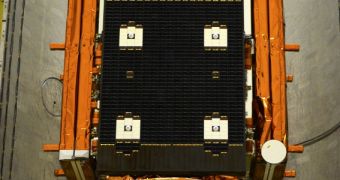After spending more than a month undergoing rigorous tests and assessments at the Kourou Spaceport in French Guiana, South America, the European Space Agency's (ESA) Sentinel-1A satellite has finally been sealed inside the Fregat upper stage of its booster, a Russian-built Soyuz medium-lift rocket.
Engineers at the facility have said goodbye to the satellite earlier today, April 1, as the rocket fairing was closed. The mission is currently scheduled to launch at around 2102 GMT (23:02 CEST) on Thursday, April 3, from the Soyuz Launch Complex (ELS) at Kourou. The facility was erected in South America by the Russian Federal Space Agency (RosCosmos), under a contract with ESA.
The Soyuz delivery system has already been rolled out and hoisted vertically atop the launch pad, and the upper stage followed suit today. The entire ensemble is now ready for fueling and launch, ESA officials say. Sentinel-1A is the first of a duo of satellites; its companion is scheduled to launch in early 2015, and will be designated Sentinel-1B.
ESA will use both spacecraft as part of its Copernicus program, which will provide environmental and weather-prediction services for the European Union and other countries. The main instrument aboard both satellites is an extremely-advanced radar capable of observing Earth through any weather conditions, as well as during both night and day.

 14 DAY TRIAL //
14 DAY TRIAL //